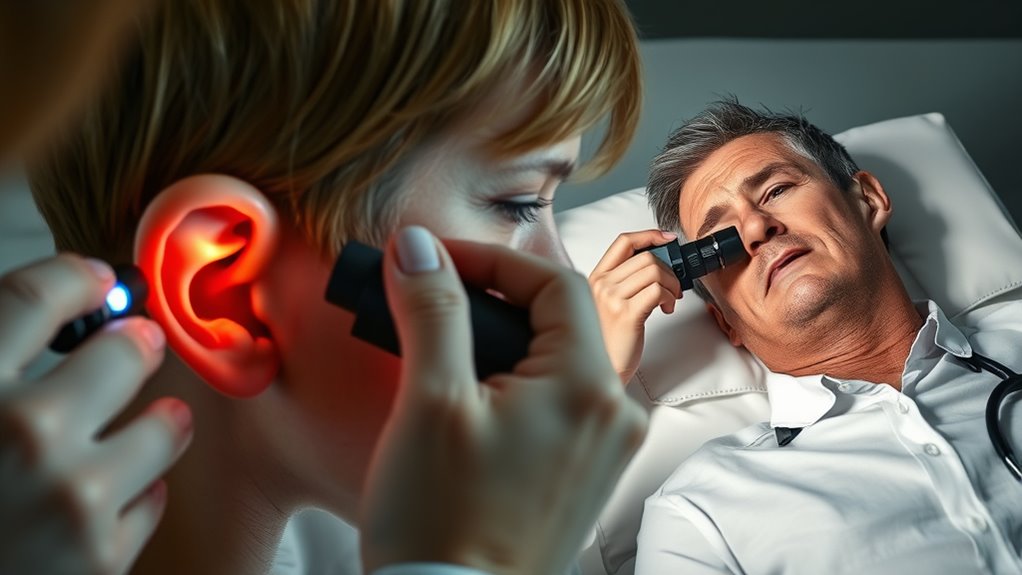When treating otitis media, adults typically manage mild cases with home remedies like warm compresses and pain relievers, avoiding antibiotics unless necessary. Children, on the other hand, often need prompt medical attention and antibiotics to prevent complications like hearing loss. Their infections tend to be more severe, requiring closer monitoring. Understanding these key differences can help you decide when to seek professional care—continue exploring to learn more about effective treatment strategies for both age groups.
Key Takeaways
- Adults often have mild otitis media that resolves with home remedies and pain relievers, while children tend to need medical evaluation and possible antibiotics.
- Antibiotics are more frequently prescribed for children to prevent complications, whereas adults often avoid them unless symptoms worsen.
- Children’s infections are usually more severe and require closer monitoring, whereas adults can often manage mild cases conservatively.
- Medical intervention in children aims to prevent long-term issues like hearing loss, while adults primarily focus on symptom relief.
- Use of home remedies is common in adults, but caution and medical guidance are essential for children to avoid delays in proper treatment.

Have you ever experienced ear pain or discomfort? If so, you know how bothersome it can be, especially when trying to figure out the best way to treat it. When it comes to otitis media, or middle ear infection, the approach can differ markedly between adults and children. One important aspect to consider is that in many cases, adults might prefer to try home remedies first, but it’s essential to be cautious about overusing antibiotics. Overprescription can contribute to antibiotic resistance, making future infections harder to treat. That’s why understanding when home remedies are appropriate and when medical intervention is necessary is key.
For adults, mild cases of otitis media often resolve on their own or with simple home remedies. Applying warm compresses to the affected ear can help ease pain and promote drainage. Over-the-counter pain relievers like ibuprofen or acetaminophen are effective in managing discomfort. Staying well-hydrated and resting also support your immune system in fighting the infection. Some adults find that using ear drops with natural ingredients, like olive oil or garlic oil, can provide relief, but these should be used cautiously and only if the eardrum isn’t perforated. It’s tempting to rely solely on home remedies, especially since antibiotics aren’t always necessary, but it’s essential to recognize when professional medical advice is needed to prevent complications. Additionally, being aware of the role of contrast ratio in the severity of the infection can help determine whether medical treatment is needed sooner.
Children, on the other hand, often require a more cautious approach. They can’t always communicate their symptoms clearly, and their infections tend to be more severe or persistent. Pediatric cases may need antibiotics to prevent complications like hearing loss or the infection spreading. That said, healthcare providers usually evaluate the severity of the infection before prescribing medication. In cases where the infection is mild, doctors might recommend watchful waiting, encouraging parents to use home remedies like warm compresses and pain relievers. Because children are more vulnerable to the risks of untreated infections, it’s crucial not to delay seeking professional care if symptoms worsen or persist beyond a couple of days.
Frequently Asked Questions
Can Adults Develop Chronic Otitis Media More Often Than Children?
You might wonder if adults develop chronic otitis media more often than children. While ear infections are common in kids, adults can also experience chronic inflammation in their middle ear, especially if they have recurrent ear infections or underlying issues. Factors like Eustachian tube dysfunction or immune responses can contribute to persistent problems. So, yes, adults can develop chronic otitis media, often linked to ongoing inflammation and repeated ear infections.
Are Antibiotics Always Necessary for Adult Otitis Media Treatment?
You might wonder if antibiotics are always needed for adult otitis media. The answer is no, not always. Overusing antibiotics can lead to antibiotic resistance and cause medication side effects. Your doctor will assess your symptoms, age, and health history to determine if antibiotics are necessary. Sometimes, watchful waiting or alternative treatments work better, especially if your condition is mild and unlikely to worsen without antibiotics.
How Does the Recovery Time Differ Between Adults and Children?
Ever wonder why recovery duration varies so much? In general, children tend to heal faster, often recovering within a week, thanks to their robust immune response. Adults may experience longer healing timelines, sometimes taking two weeks or more. Do factors like age really influence recovery? Yes, and understanding these differences helps you manage expectations and seek appropriate care promptly. Your body’s response plays a key role in healing timelines for otitis media.
Can Diet or Lifestyle Influence Otitis Media in Adults?
You might wonder if diet impact and lifestyle factors influence otitis media in adults. While diet alone isn’t a direct cause, maintaining a healthy diet boosts your immune system, helping prevent infections. Lifestyle factors like smoking, allergies, and stress can increase your risk of developing otitis media. To reduce your chances, focus on good nutrition, avoid smoking, manage allergies, and keep stress levels low, supporting your ear health overall.
Are There Alternative Therapies Effective for Adult Otitis Media?
Imagine your body as a garden needing gentle care. You might try natural remedies or homeopathic options to soothe adult otitis media, but their effectiveness varies. While some find relief with eucalyptus oil steam inhalation or herbal supplements, scientific evidence remains limited. Always consult a healthcare professional before trying alternative therapies, as they can complement conventional treatments and ensure your health garden stays balanced and thriving.
Conclusion
Understanding the differences in treating otitis media for adults and children is like steering a delicate dance—you must listen closely to each step. With patience and care, you can guide your loved ones through the storm of infection toward the calm of healing. Remember, every ear holds its own story, and your gentle approach can turn a painful chapter into one of relief and recovery, shining hope like a lighthouse in the night.











